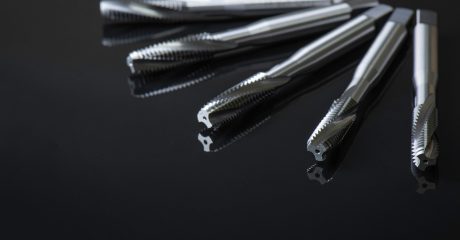There are many different types of thread taps, and knowing exactly when to use each will make your job faster and easier. Each type of thread tap has varying advantages and disadvantages; in part 1 of this guide we discuss those in detail so you can make an informed decision.
Hand Taps
Hand taps are the most common types of taps, but the ones you can buy in the hardware store are generally less durable and shouldn’t be used for CNC work. Instead, purchase hand taps specifically made for CNC machining; you’ll be surprised at the difference in quality and durability.
There are two types of Hand Taps, Taper Taps and Bottoming Taps. A taper tap has quite a lot of taper to help it ease into cutting threads gradually. A bottoming tap has almost no taper at the end because it is designed to thread all the way to the bottom of its reach. These two taps are used in unison; taper taps first to thread most of the hole and then bottoming taps to finish the rest.
Plug Tap
Plug Taps are in between Bottoming and Taper Taps because they have 3-5 threads tapered. Unfortunately, terminology for this tap type is not always consistent; some vendors instead call these “Second Taps” so when purchasing, pay attention to what you’re getting and using.
Power Taps
These are the types of taps you should choose from for CNC applications or for manual machining work. The most common two types are Spiral Point Taps and Gun Taps.
- Spiral Point Taps – These taps have a spiral cut with relief grooves.The spiral angle on the front cutting edge helps move chips and gives superior cutting performance. The primary disadvantage of this tap type is they push the chips down into the hole. This is not a big deal for through holes, but is bad for blind holes.
- Gun Taps – These taps have an open spiral just like an endmill. Their primary advantage is they eject chips up and out of the hole. They’re always preferable over spiral point taps when you have a blind hole. They’re also preferable for an interrupted hole where another feature intersects because the spiral helps restart the threading past the open feature.
Interrupted Thread Tap
These thread taps only have a tooth for every other thread. The idea behind this is to provide improved chip extraction. Removing every other tooth helps break chips, provides more room for the chip to escape, and allows for lubricant to come in and do its job.
Contact Custom Tool Today!
If you’re looking for a reliable CNC machining or tool regrinding services, contact us today. Our team of experts is ready to help you achieve the highest level of precision and accuracy in your components.
